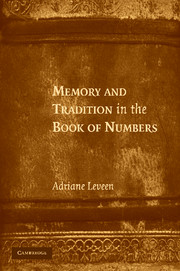Book contents
- Frontmatter
- Contents
- Acknowledgments
- ONE Desert Bound
- TWO Weaving by Design
- THREE Priestly Purposes
- FOUR Variations on a Theme: Shaping Memory in the Wilderness
- FIVE Crisis and Commemoration: The Use of Ritual Objects
- SIX Falling in the Wilderness: The Politics of Death and Burial
- SEVEN Inheriting the Land
- APPENDIX A The Priestly Sphere of Activity in the Book of Numbers
- APPENDIX B The Use and Variation of God's Address to Moses and to Aaron
- APPENDIX C Death Reports
- APPENDIX D Proper and Improper Treatment of the Dead
- Notes
- Bibliography
- Index
- Scriptural Index
- Selected Hebrew Index
APPENDIX B - The Use and Variation of God's Address to Moses and to Aaron
Published online by Cambridge University Press: 21 July 2009
- Frontmatter
- Contents
- Acknowledgments
- ONE Desert Bound
- TWO Weaving by Design
- THREE Priestly Purposes
- FOUR Variations on a Theme: Shaping Memory in the Wilderness
- FIVE Crisis and Commemoration: The Use of Ritual Objects
- SIX Falling in the Wilderness: The Politics of Death and Burial
- SEVEN Inheriting the Land
- APPENDIX A The Priestly Sphere of Activity in the Book of Numbers
- APPENDIX B The Use and Variation of God's Address to Moses and to Aaron
- APPENDIX C Death Reports
- APPENDIX D Proper and Improper Treatment of the Dead
- Notes
- Bibliography
- Index
- Scriptural Index
- Selected Hebrew Index
Summary
The details of the address
The formula השמ לא הוהי רבדיו occurs at least forty-two times.
It also occurs a few times with the addition of Aaron.
A different version השמ לא הוהי רמאיו appears in Numbers 11:16 and 23, a distinct unit (likely to be nonpriestly) concerning the gathering of seventy elders and of quail that the redactor might have left untouched from an earlier version. In addition, the same formula reappears in chapter 12, also a distinct, nonpriestly unit containing the challenge of the siblings against Moses.
God also speaks only to Aaron: ןורהא לא הוהי רמאיו
Interpreting the distinctions in address
The more common formula of רמאל השמ לא הוהי רבדיו is found in almost every chapter of Numbers. It usually introduces a new piece of legislation or a commandment that requires the weight and authority of God. The formula creates a situation in which Israel becomes “the special creation by word (commandments and the like) of God….” Certain traditions – the precise treatment of skin eruptions, confessions of wrongdoing, the steps in becoming a nazir – are being legitimated by the authority of divine command.
Aaron is included in the formula when the topic to be introduced directly concerns him, especially in Numbers 4 when the dominance of Aaron and his sons over the Levites is clearly established. There are also times when God addresses only Aaron, such as in 18:1, 18:8, and 18:20. Chapter 18 contains matters of great priestly concern.
- Type
- Chapter
- Information
- Memory and Tradition in the Book of Numbers , pp. 185 - 186Publisher: Cambridge University PressPrint publication year: 2007



